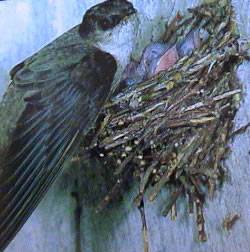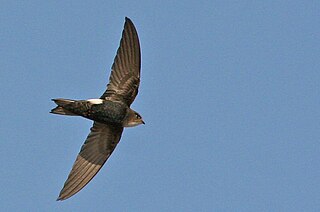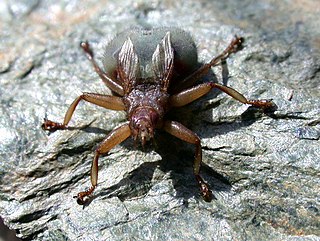
The common swift is a medium-sized bird, superficially similar to the barn swallow or house martin but somewhat larger, though not stemming from those passerine species, being in the order Apodiformes. The resemblances between the groups are due to convergent evolution, reflecting similar contextual development. The swifts' nearest relatives are the New World hummingbirds and the Southeast Asian treeswifts.

The Apodidae, or swifts, form a family of highly aerial birds. They are superficially similar to swallows, but are not closely related to any passerine species. Swifts are placed in the order Apodiformes along with hummingbirds. The treeswifts are closely related to the true swifts, but form a separate family, the Hemiprocnidae.

The alpine swift is a species of swift found in Africa, southern Europe, and Asia. They breed in mountains from southern Europe to the Himalayas. Like common swifts, they are migratory; the southern European population winters further south in southern Africa. They have very short legs which are used for clinging to vertical surfaces. Like most swifts, they never settle voluntarily on the ground, spending most of their lives in the air living on the insects they catch in their beaks.

The little swift, is a small species of swift found in Africa and southwestern Asia, and are vagrants and local breeders in southern Europe. They are found both in urban areas and at rocky cliffs where they build nests in a way typical of all members of the order Apodiformes. The genus name Apus is Latin for a swift, thought by the ancients to be a type of swallow without feet. The Latin specific affinis means similar to or related to, but in this case the species that the little swift supposedly resembles is not clear from the description. A population formerly considered to be an eastern subspecies of little swift is now separated as a distinct species, the house swift.

The house swift is a species of swift in the family Apodidae. It is found in Japan, Nepal, and Southeast Asia. It is capable of flying long distances by alternately shutting off hemispheres of its brain in-flight.

The pallid swift is a swift. Swifts have very short legs which they use only for clinging to vertical surfaces. The genus name Apus is Latin for a swift, thought by the ancients to be a type of swallow with no feet, and pallidus is Latin for "pale". They never settle voluntarily on the ground. Swifts spend most of their lives in the air, living on the insects they catch in their beaks. They drink on the wing.

The Pacific swift is a species of bird that is part of the Swift family. It breeds in eastern Asia. It is strongly migratory, spending the northern hemisphere's winter in Southeast Asia and Australia. The general shape and blackish plumage recall its relative, the common swift, from which it is distinguished by a white rump band and heavily marked underparts. The sexes are identical in appearance, although young birds can be identified by pale fringes to the wing feathers that are absent in adults. This swift's main call is a screech typical of its family. It is one of a group of closely related Asian swifts formerly regarded as one species.

The bird genus Apus comprise some of the Old World members of the family Apodidae, commonly known as swifts.

Chaetura is a genus of needletail swifts found in the Americas. Although they resemble swallows, the two are not at all closely related; this is instead a result of convergent evolution. Some members of Chaetura are long-distance migrants, while others are year-round residents.

The Horus swift is a small bird in the swift family Apodidae that is found in sub-Saharan Africa. Horus, whose name this bird commemorates, was the ancient Egyptian god of the sun, son of Osiris and Isis.
Bates's swift is a species of small swift in the family Apodidae which is found in western Africa.

Bradfield's swift is a species of swift in the family Apodidae.

Collocalia is a genus of swifts, containing some of the smaller species termed "swiftlets". Formerly a catch-all genus for these, a number of its former members are now normally placed in Aerodramus.

Cypseloides is a genus of swifts in the family Apodidae. It contains eight described species. They occur mainly in Central and South America. The exception being the American black swift, which has a wide range into North America.

Hirundapus is a genus of swifts in the family Apodidae. The name Hirundapus is constructed from the names of the swallow genus Hirundo and the swift genus Apus.

Panyptila is a genus of swifts in the family Apodidae. The two species are found in Central and South America.
The mottled swift is a species of bird in the swift family, Apodidae. It is one of two species in the genus Tachymarptis together with the alpine swift. It occurs widely in eastern Africa and locally in western Africa. It is found in Angola, Burkina Faso, Burundi, Cameroon, Central African Republic, Chad, Democratic Republic of the Congo, Ivory Coast, Eritrea, Ethiopia, Gabon, Ghana, Guinea, Kenya, Malawi, Mali, Mozambique, Nigeria, Rwanda, Sierra Leone, Sudan, Tanzania, Togo, Uganda, Zambia, and Zimbabwe.

Crataerina is a genus of louse flies in the family Hippoboscidae. All are parasites of birds, feeding on the blood of various species of Apodidae (swifts) and Hirundinidae. The genus is sometimes spelled Craterina.

Scaniacypselus is an extinct genus of basal swifts from the Eocene of Denmark, Germany and France. Many well preserved specimens still showing plumage were discovered in the Messel Pit near Darmstadt, Germany. Species of Scaniacypselus had relatively broader wings than modern swifts and hindlimbs better adapted to perching on tree-branches, indicating that the bird was not as aerial as its extant relatives and likely nested in trees like hummingbirds and treeswifts. Two species are recognized, S. wardi and S. szarskii.

























